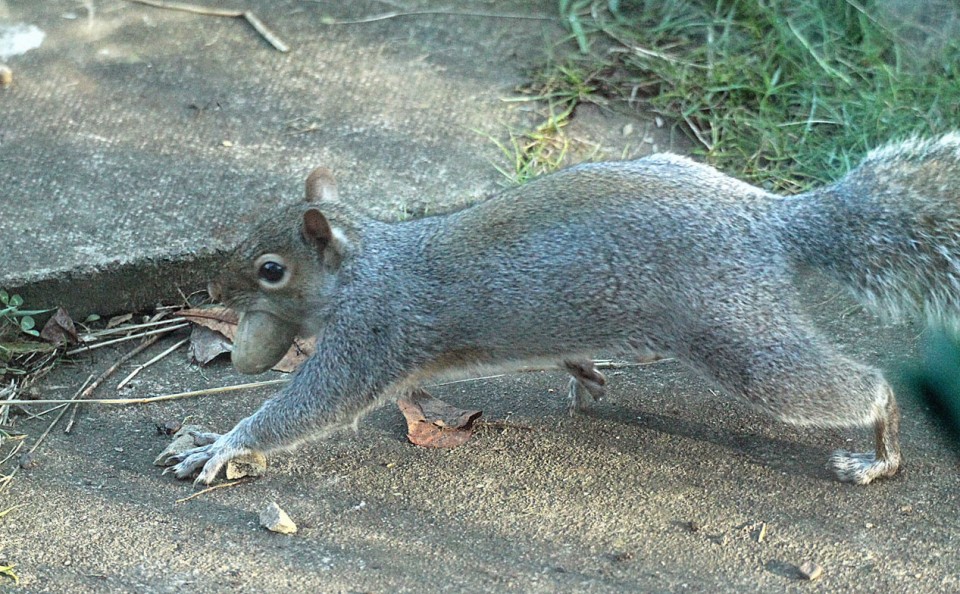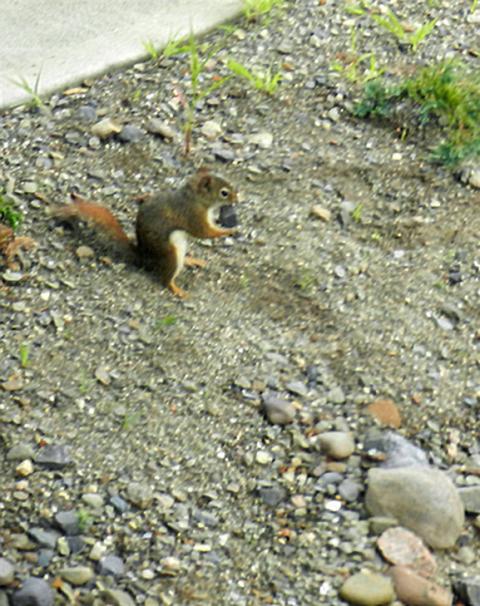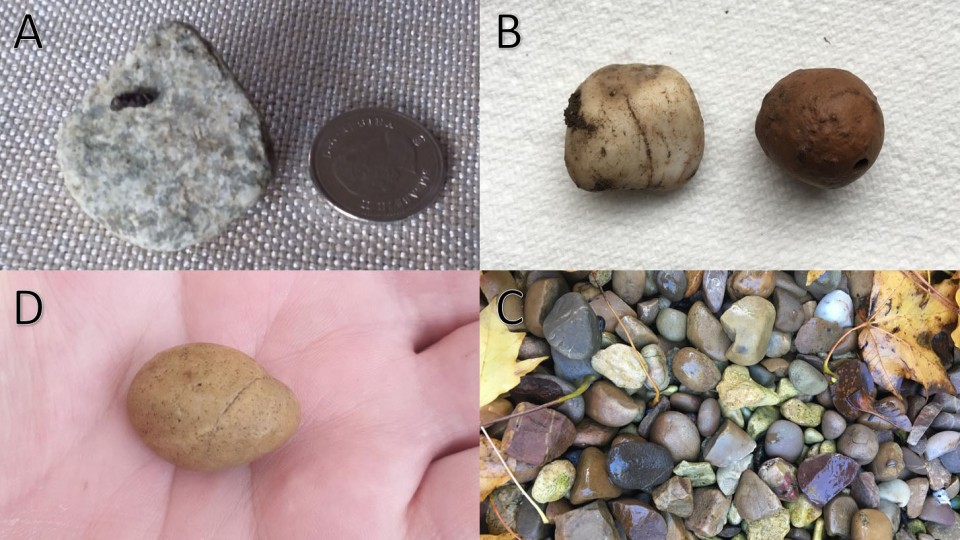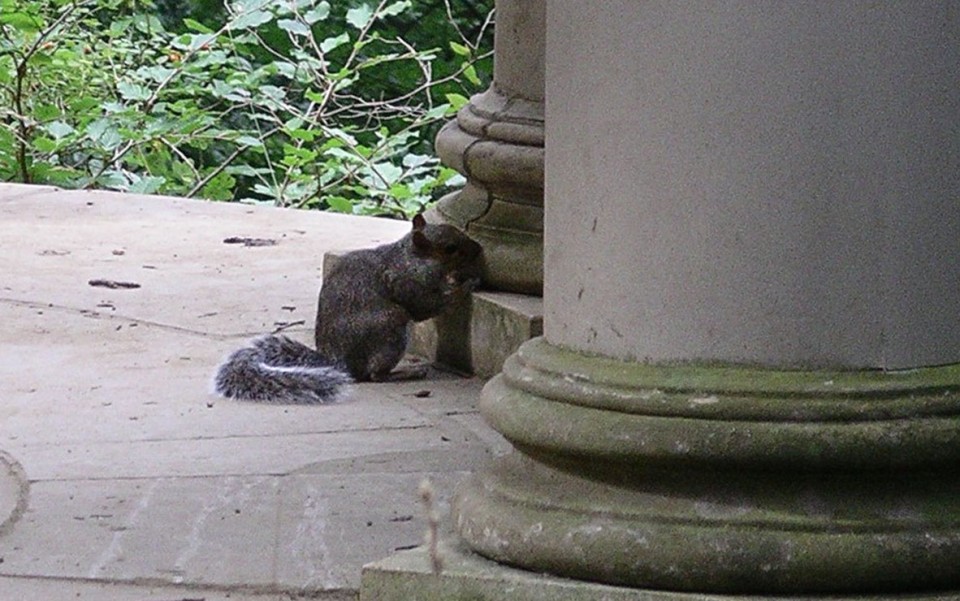Squirrel Stone Caching, Dust-bathing & Sitting High
As with almost any species, there are some facets of behaviour that are more difficult to explain than others; squirrels are no exception. Three behaviours in particular warrant further attention: caching of non-food objects, typically stones; dust bathing; and a particularly curious behaviour where a squirrel will sit up high for hours on end without moving that I've called "sitting high".
Stone caching
A great many species of mammal are known to hide surplus food for later retrieval, a process known as caching (pronounced "cashing", from the French cacher, "to hide") and squirrels are among some of the most proficient cachers known to science, even going so far as organising their larders to help them remember what's stored where. There are, however, a few intriguing reports of squirrels taking inedible objects and caching them.

The first time I came across this behaviour was in an account from New Year's Day 2005, when Maria Salmon contacted veteran squirrel biologist John Gurnell about some strange behaviour she had seen from a Grey squirrel visiting her garden. The squirrel had been stealing pebbles, each about the size of a walnut (i.e., approx. 5 x 3.5 cm / 2 x 1.5 in.), every day for weeks -- to the point where Ms. Salmon needed to buy some more. This curious behaviour continued until at least the end of February and apparently the squirrel, one of several visiting the property, would come into the garden and make straight for the pebbles, ignoring the food put out, and carry one off somewhere. It was never established where the stones were being taken (the squirrel didn't always leave in the same direction) or what was happening to them.
In August 2010, a user posted to the online RSPB Community forum recounting similar behaviour; a squirrel was taking gravel and pebbles from their garden "usually after licking it all over". When larger pebbles were added, the squirrel shifted its attention to these and it would typically pick up four or five before it settled on one to take, suggesting there was a specific trait the squirrel was seeking. In this individual's case, however, while some stones were cached, others were left on fence posts, on the summer house roof or under the summer house. Subsequently, I've come across reports online of similar stone-burying behaviour from Greys both here, in the USA (Maine and California) and Canada (Peterborough, Ontario). In some cases the stones were licked first, but in all cases the stones were removed and either buried or assumed to have been buried.

In April 2011, a lady contacted me describing how:
"A cheeky grey squirrel runs up to the house from the bottom of the garden, sniffs the ground for a few seconds then carefully selects a rather large piece of gravel (c. 2 cm in length, smooth, more of a small pebble), puts it in his mouth, finds another the same size and puts that in his mouth too, then runs off down to the conifers at the bottom of the garden!!"
The squirrel was doing this most of the day and had removed quite a few stones.
In December 2018, Vicky Harrison got in touch to tell me about Greys visiting her property that "consistently take small stones from my garden and bury them, usually next door". Vicky first noticed this behaviour in the winter of 2017, and it appeared to be just a single individual that was collecting pebbles who was "very particular about the size (acorn) and shape (smooth) of the selected stones". By the following autumn four of the five or six visiting squirrels were doing it and, in some cases, jagged stones were taken. The stones were taken throughout the day and mostly buried in a neighbouring garden, although Vicky found several in her flower pots.
Between August and November 2020, I received 11 reports of "stone stealing" behaviour; seven were from the UK (including Sussex, Oxfordshire, County Durham and Edinburgh) and three from North America, one in Minnesota and two in Canada. All the descriptions have the same basic elements in common: one or two squirrels carefully select stone, rotate them in their forepaws often while licking them and then take them away. In several of the videos I have been sent, the squirrel can clearly be seen burying the stone before returning for another, while in others the squirrel disappears. Even in the reports that don't see what happens to the stones, the speed with which the squirrel returns suggests they're being cached. The stones vary in size and shape from acorn-sized to walnut or slightly larger ("boiled egg cut in half" as one observer described it to me). In only one case so far has a colour preference been evident. Jane Hankinson told me:
"The stones are about the size of an acorn and interestingly always a dark brown colour, even though I have a mixed colour pebble area in the garden."
Thus far, all but one report I have found involve Grey squirrels and I have yet to come across an example of the behaviour in European Reds, although this may simply reflect the Grey's more cosmopolitan distribution and propensity for visiting gardens. This behaviour is not, however, exclusive to Greys and in August 2020 Keith Guise, from New Brunswick on Canada's east coast, contacted me to describe repetitive stone caching behaviour by an American Red squirrel (Tamiasciurus hudsonicus) visiting his isolated mountain garden. Keith described how the squirrel selects smooth rounded grey stones about 2.5-3.5 cm (1-1.5 in.) in diameter and either disappears off into the forest with them or leaves them around the garden in the plant pots. This happens throughout the summer and Keith told me:
"... we see it about four or five times per day but there could be more; it goes to great trouble to choose the one it wants, picking them up putting them in its mouth, turning the stone around until it has the "best" one; always heads off on the same route down our mountain ..."
This is certainly intriguing behaviour and not something I, or many squirrel biologists based on my research, have ever observed personally.

I have been unable to find any reference to this in the literature and Max Planck squirrel biologist Pizza Ka Yee told me that, despite being curious about it, she has never seen the behaviour. Lucia Jacobs, a neuropsychology professor at the University of California, Berkeley, who has spent much of her academic career study caching behaviour in Greys, has observed the caching of non-food items only very rarely -- in one case a squirrel stole their experimental cue, which was shaped like an ear of corn, and cached it. regardless, all accounts describe a patient deliberation about the selection of the stones and the regularity with which it is carried out, suggesting some purpose the squirrel was invested in.
Unfortunately, there are still a great many unknowns about this behaviour. We don't know if it is sex- or age-specific, for example, although several of the reports I've received have suggested yearlings. We also don't know whether the stones are ever retrieved or relocated, as regular caches are. We do know that squirrels are very proficient when it comes to selecting seeds for caching and have a good sense of smell, which might suggest they're unlikely to have mistaken the pebbles for food. Indeed, Alan Walker in Shropshire told me that the squirrel taking stones from his garden dropped the stone it was carrying when took the walnut he was offering instead. Similarly, in Vicky's description, squirrels visiting across years exhibited the behaviour, implying they were presumably feeding themselves in between these bouts of pebble caching. Several other readers who have provided their observations feed squirrels in their garden and watch them cache both stones and nuts during the same observation period.
Thus far, there appear to be three theories offering an explanation for this behaviour. One suggests, based on finding stones in the lining of a squirrel's drey, that they may be used as ballast or even 'radiators', although, in my view, this is an unlikely explanation and it seems probable that the stones were incidental inclusions.
A second hypothesis, provided by Natural Heritage Information Centre zoologist Don Sutherland, considers that it may be an attempt to disguise food caches and reduce cache-pilfering by other squirrels. Off-hand, it seems this could work in two ways: it may serve to 'dilute' the caches such that any potential thief would potentially uncover a stone for their trouble rather than a nut; or a stone could be placed on top of a food item to fool a potential pilferer. I've not come across evidence to support either of these in the current observations, but both seem plausible, although when Fiona Turner dug up one of the caches in her Oxfordshire garden, she found only the stone.
Thirdly, and in what is probably a logical extension of the aforementioned, Professor Jacobs points to research by scientists at the Konrad Lorenz Forschungsstelle, part of the University of Vienna's Faculty of Life Sciences, which found ravens openly cached small toys (i.e., low value items) they were given when in the presence of competitors, but hid food (high value) more diligently. The researchers suspect that the ravens do this to practice being pilfered from, and it's possible squirrels do something similar with the stones they take.
Taking the idea of cache pilfering practice and cache dilution a little further, it is tempting to speculate that stones may be used either to help evaluate a new storage site, keep a competitor busy and/or dissuade them. To the first point, we know some squirrel species appear to organise their caches to help them remember what's stashed where and that memory and eyesight seem to play the most significant point in cache retrieval. If Greys operate a similar grouping tactic, they might be able to use stones to "test out" caching locations at relatively low cost; they're losing stones, not food. If they bury stones around the place and they all remain in situ it's probably a good hiding spot. If the stones get dug up or moved, maybe this is a place best avoided. Similarly, Squirrel A, having watched Squirrel B busy making caches in an area, may spend its time scouring this spot (and finding only stones) rather looking elsewhere where the food is hidden. If Squirrel A only ever finds stones upon pilfering Squirrel B's caches, could it decide not to bother going after this individual's caches in future?
A final thought, and one I confess shows limited promise relative to the above, is that the squirrels may be using these stones as a mineral source. Most reports of this behaviour describe the squirrel licking the stone before taking it away and while I believe some observations are actually just the squirrel rotating a stone in its mouth trying to find a secure grip, several do give the strong impression that the squirrel is genuinely licking it. In one example, Richard Stallard described licking behaviour in squirrels taking stones from under the bird feeder in his Sussex garden and, when I mentioned a possible mineral source, noted that he'd been distributing salt in his garden to try and reduce the slug population and that, living on the coast, they get salt deposited on the house and garden from sea spray. Similarly, Nikki Wyrill from Dorset observed a squirrel very selectively removing stones from her garden and suggested to me "I also live on the coast in a very windy area - so perhaps the theory of salt deposits on the stones may be true".
We know squirrels will use mineral licks and that mineral deficiencies, particularly low calcium levels, have been linked with bark-stripping behaviour. In the early 1980s, Lawrie Tee tried, albeit unsuccessfully, to reduce bark-stripping by providing a mineral lick for Grey squirrels, while Alexander Panichev and colleagues recorded Red squirrels visiting "kudurs" (mineral rich soil outcrops that are eaten by animals) in Russia's Sikhote-Alinsky Biospheric Reserve. More recently, reader Jon Southwood got in touch to describe a Grey squirrel he observed and photographed licking at a stone column at Fountains Abbey in Yorkshire - the squirrel seemed very determined and ignored Jon taking photos. Finally, Fiona Turner contacted me when she observed what appeared to her to be a youngster taking stones from her garden. What made Fiona's account particularly intriguing is that this behaviour only started when they replaced the balmullo gravel aggregate with Douglas Muir quartz. Photos and descriptions from other readers suggest quartz/quartz-like stones are often chosen. If mineral deficiency is a driver behind this curious behaviour, this may account for the squirrels being so discerning in their selection of stones.
So, at this point, we can't say with any certainty why squirrels take and bury stones. In my view, the idea that they're using it as a pseudo/dummy/test cache seems to make the most sense, but even this theory is not without its holes, so to speak. The squirrels aren't obviously being watched, and make no attempt to "fake cache" the stones as they do with food when they think someone's looking. This behaviour also seems all encompassing; a single squirrel will bury dozens, perhaps hundreds, of stones over a season, which presumably impacts its ability to cache food to see it through the winter. As such, this may actually be an aberrant behaviour. Unfortunately, no stone caches have yet been methodically studied, so we don't know whether they normally contain food as well, although some anecdotal reports suggest some do, or whether the owner ever returns. I would be very interested to hear from readers who have observed this behaviour or have theories as to its purpose.

Dust bathing
Animals, particularly birds, rolling around in dirt or sand is not an uncommon sight. This is a phenomenon we refer to as a maintenance behaviour, because we think it helps rid the bather of parasites, while also probably helping soak up excess oils in fur and feathers to keep them and the skin in good condition. For mammals, this is largely speculative, but in the case of some birds, chickens in particular, we know that they develop skin conditions if denied access to a dust bath, suggesting it is essential for their wellbeing.
Interestingly, despite this being a behaviour often recorded in ground squirrels, dust bathing appears less commonly witnessed among tree squirrels and I have yet to find a reference to it in the literature. I have, nonetheless, come across a handful of reports online, and had some readers readers contact me, describing Greys rubbing themselves on the ground, in wood fragments of decomposing logs, and even in flower pots. In other words, engaging in what appears to be dust bathing. Additionally, Edythe Butler recently contacted me to describe six American Red squirrels (T. hudsonicus) dust bathing in rotting tree stumps in Quebec, Canada, during the spring of 2024. (I would be interested to hear from anyone who has observed similar behaviour in Eurasian Reds.) These accounts have a couple of elements in common: they occur in dry dirt or dry crumbling wood -- I'm not aware of any examples of mud wallowing behaviour in squirrels -- and are typically punctuated by bouts of grooming and scratching.
It is also worth noting that some of the same body and chin rubbing that is associated with scent marking is often observed during dust bathing; this may be coincidental, or it may imply that dust baths have a role in territorial maintenance as well as pelage maintenance. Certainly, this seems to be the case in some rodents and in his Ph.D. on Belding's ground squirrel (Urocitellus beldingi) ecology, issued in 1972, University of Arizona biologist Larry Turner described how these rodents dust bathed as part of their grooming regime as well as during aggressive encounters with intruders. Turner noted that squirrels often rubbed their upper backs while bathing, apparently depositing scent from the dorsal skin glands that lie in the shoulder region:
"Secretions from this gland leave an odor in dust bathing areas, and at the same time, the dust absorbs excessive secretions which might mat the fur. Thus dust baths may serve the dual function of scent marking an area and personal cleanliness."
Interestingly, five of the Tamiasciurus squirrels Edythe watched dust bathing were suffering from mange. Skin infections or parasites might make squirrels more disposed to such behaviour, although one of Edythe's squirrels, as well as all Greys I have had described to me, dust bathed despite not suffering from any apparent skin disorder. Edythe noted that all the squirrels seemed to enjoy dust bathing and told me: "I think it is very likely that wildlife uses the clean dried out wood fibres in stumps of trees to keep their fur coat clean, and also to help get rid of mites and fleas etc.". As far as I know, no studies have thus far been conducted on dust bathing sites of grey squirrels to know whether there are particular criteria that the squirrels seek out, or whether any detectable scent remains after bathing. We also don't know how frequently bathing occurs, or whether squirrels use the sites as both a kind of "community noticeboard" as well as a "spa". It nonetheless appears to be an uncommon behaviour among tree squirrels and is therefore presumably not an essential aspect of fur/skin management as it is in, for example, some bird species.
Sitting up high
Over the spring of 2020, I received four accounts of squirrels apparently taking prolonged refuge up high, and in December 2021 a similar observation was posted to a Facebook group. Two cases involved squirrels sitting right at the top of a tree, one atop a telegraph pole, the fourth on the side of a person's house, up by the apex, and the most recent one an adult Grey remained 'frozen' in the same location in a tree in the observer's front garden in Shropshire. In all these cases, the animal remained there for several hours and in a couple of instances for more than 24 hours. In the example given to me by Claire Moylan in April 2020, for example, the squirrel sat motionless in the top of a tree at the bottom of her garden for just over 24 hours, ignoring food she left at the bottom for it, before it simply climbed down and ran off. During this time, the squirrel sat upright (not obviously sunbathing) and didn't vocalise while Claire was watching. The following month, Bob Cole described a similar, but slightly different, behaviour in a Grey outside his house:
"We have a grey squirrel which for the past 4 days has been sitting on top of a telegraph pole in the garden for several hours each day. The first day there was lots of 'barking' and alarm calls, but not so much since."

In only one case was this aerial freezing behaviour seen to follow a traumatic encounter. Surrey-based writer and designer Siobhan O'Neill described an incident in which one of the squirrel frequenting her garden was caught by a neighbour's cat:
"... but let her go as I went charging out after them. She sat terrified in a tree at the end of our garden for hours. We kept checking and put water and nuts on the roof of our nearby shed for her but eventually she recovered and left."
Taken together, these accounts tentatively suggest that, following a distressing event, a squirrel may seek safety up high. At first appraisal, these locations may seem rather exposed, but that may be of benefit to the squirrel if its main concern is ground predators. The squirrel presumably remains in the location until either it feels safe again, or is driven down by hunger/thirst.